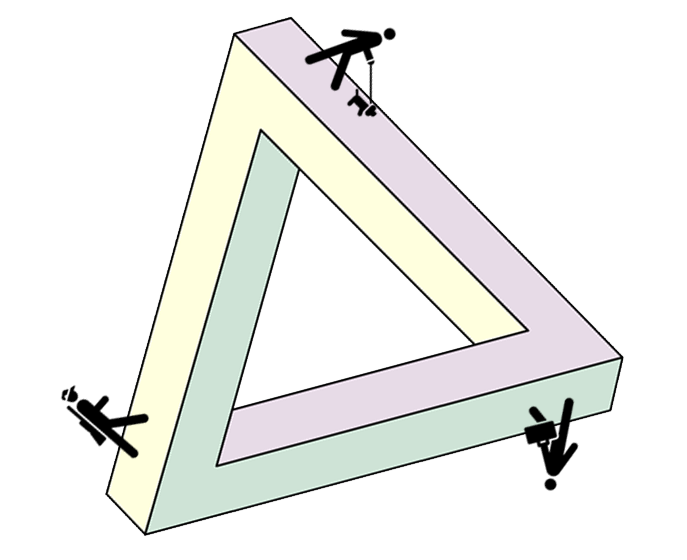There is a place in your company where good intentions fade. Where projects go in, but few ever come out. It’s the Brand Bermuda Triangle – the gap between sales, marketing, and IT. These three corporate functions often work in silos. On a good day, they work cooperatively, but too often, not very collaboratively. But the times they are a changing’.
What's happening
As the cost of digital tools decreases, there is an opportunity to lower the cost of customer interactions for companies of all sizes. We're living in a world of evolved and increasingly integrated technologies (and acronyms): CMS(Content Management Systems), SEO (Search Engine Optimization), SEM (Search Engine Marketing), CRM (Customer Relationship Management), and MA (Market Automation). Each can play an important new role in your marketing and sales strategy. To get the most out of these new ideas, you need to have a decent understanding of what these tools do, and how the customers travel between your brand’s digital and physical presence.
Today, everybody Googles everything. Business-to-Business brands are not exempt from these trends, as a Google-CEB study determined that B2B buyers are more than half-way through making a purchasing decision before contacting a sales rep. Digital analytics makes it possible to optimize sales and marketing tactics. It's clear that your website should be more than just an online brochure.

We've worked with a lot of different companies. Each has different organizational dynamics between sales, marketing, and IT. In some organizations, marketing leads sales, in others, sales leads marketing. In many cases, IT is underutilized, or more likely no one even knows what IT does.
Today, a greater emphasis on online conversion and purchasing decisions is putting these three groups in the same room more than ever. Today's customer demands a brand experience that blurs sales and marketing and is enabled by new technology.
What's not happening
New digital tools blur the lines between sales, marketing, and IT and creates confusion. Over the last decade, it was hard enough to answer the question: Who owns the website – marketing or IT? Automated lead generation and nurturing connected with CRM systems add sales to the mix. For many organizations, it's not clear who should take the lead.
Historical best practices in each category allow them to operate in parallel. Now these groups have to collaborate truly, not just cooperate - and most companies are not set up for that. Collaboration is a buzzword, but quite difficult to achieve in practice. Pride, ownership, ego, a lack of understanding, your internal culture, and company politics can get in the way of genuine collaboration. Marketing is working on its initiatives, often striving for more consistency and high-minded approaches – but usually behind the eight ball. Sales is looking to meet critical numbers and will use whatever works to get the job done, congruent or not. IT is divided and attempting to serve multiple masters, and feels both liable and not in control. Everyone is moving in different directions at a furious pace, using different metrics and measures of success.
What can help
A first step for team members to get on the same page is to get out your lane. Stop protecting your industry orthodoxies, and step back to view the bigger picture. Gaining this perspective can be difficult, even for organizations with strong leadership. Organizations sometimes need a fresh perspective and a push. There are a few steps that can help.
Everyone and every company can benefit from a tighter focus. Just as you can never know too much about your customer, you can always get even more focused. In today's fragmented and changing landscape, this is a vital step for nearly all organizations today. It means getting stakeholders from a variety of levels and departments involved to both level-set and start to look at the better future state. It means better understanding of what's happening on the ground with your customer, how technology can help, and defining your path forward. That path is based on your desired brand meaning.
In addition to asking "What do we do?" Consider: "What are our customers joining?
A greater sense of focus leads to better alignment. In fact, one of the biggest indicators of a lack of focus is a lack of alignment. Organizing your customer-facing initiatives not only improves your brand experience but helps empower internal teams.
Aligning your strategy to tactics seems obvious, but can be hard to do in the wake of new tools. Exploring new approaches – through the lens of your customer, rather than your internal teams – encourages collaboration. Externally, it yields higher quality, more integrated customer interactions, and ultimately moving customers through your sales cycle in a more cohesive way. Achieving a better system demands new collaboration, new tools, and possibly new kinds of teams beyond traditional sales, marketing, and IT.
What are the key customer interactions that will lead them to our desired brand perception? What should be the character of each customer interaction, whether digital, physical or personal?
It’s not easy, but your initiatives can emerge from the Brand Bermuda Triangle. You'll have to overcome historical orthodoxy and consider how your customers are experiencing your brand more holistically with today's new digital reality. Your organization may have to change, building new bridges between sales, marketing, and IT departments. You may need new kinds of teams, language, and metrics.
Start by getting everyone to join the same mission. It'll help teams best use their skills to create a customer experience that generates sales on the short term, positions your brand for the long term, and leverages emerging technology for a competitive advantage.
Penrose triangle from Wikipedia; people icons by Alexander Wiefel on The Noun Project.